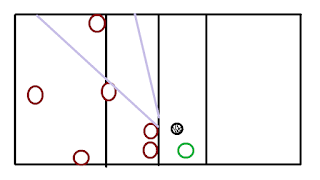often, but sometimes a hitter catches me out of position and the ball is played at my face.
Playing a free ball, a ball sent over by the opponent by bumping, versus an attack from an opponent is very different. "The overhand pass should be used whenever possible (except on serve reception and when digging), because it is a very accurate method of passing the ball," (Dunphy, Wilde 35). Volleyball Essentials advises that players use overhand passing for free balls and balls in general that have a high arc to their movement. I found that this method of passing is very accurate and more relaxing, probably because you stand up to pass the ball instead of bending down. Overhand passing is very easy for me when the arc is high.
That leads to my trials with this technique on digging with overhand passing. Dunphy and Wilde tell the reader in their book that the hands of the player preparing to set should be ball shaped, as if the ball could be set in the hands and perfectly fit (Dunphy, Wilde 36). This is not as easy as it sounds for players who aren't setters. Overhand passing the ball is awkward and tricky on digs. For me, I have to process whether or not the ball is going to be coming at my head. By the time I get my hands to my head, they are not ball-shaped, they are just up in defense. This makes it difficult to make a good pass. I tried to make overhand passes, but the truth is balls that come at the left back defender's face is either out or a free ball. Practicing this skill was hard, but when I did focus on getting my hands ball-shaped, I was able to control the ball better.
With many high school defenses having the opposite defenders of an attack on the line, why do you think it's important that those players also be able to use their hands and overhand pass as well?
Dunphy, Marv, and Rod Wilde. Volleyball Essentials: Video-Text. Total Health Publications, 2014

No comments:
Post a Comment